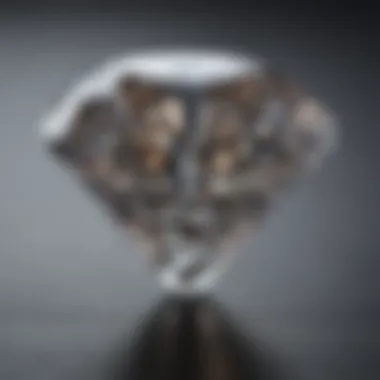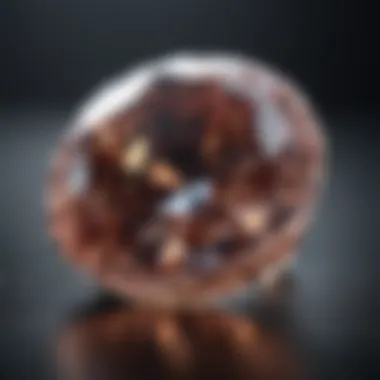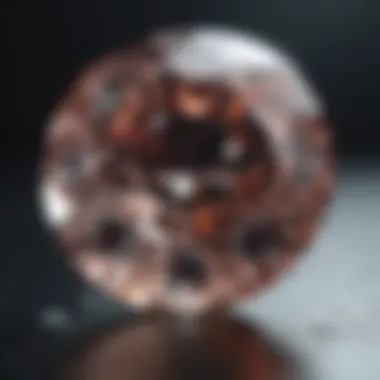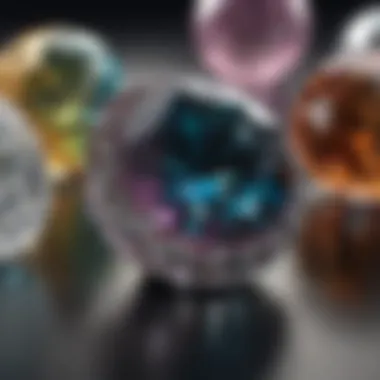Factors Influencing One-Carat Diamond Pricing


Intro
When one thinks of diamonds, it’s easy to get lost in a whirlpool of glimmering facets and lofty dreams. Judging by their allure, it seems straightforward to determine their worth. Yet, the truth is far more intricate. The price of a one-carat diamond isn’t just a reflection of its size but a cocktail of various elements including its quality, market dynamics, and even personal taste. As we peel back the layers, we’ll uncover what really drives affordability and desirability in the diamond world.
Gemstone Overview
Definition and Origins
Diamonds are a form of carbon that undergoes immense pressure and heat deep within the Earth’s mantle before emerging as one of the hardest natural substances known. A one-carat diamond, specifically, refers to a diamond weighing precisely 0.2 grams.
Historically, diamonds have captured human fascination for centuries, thought to bring luck or symbolizing power. They trace their origins to ancient India, where they were first mined and associated with the divine. This celestial connection has persisted throughout history, weaving diamonds into the fabric of various cultures.
Historical Significance
Diamonds have not only adorned royalty but also signified significant moments in history. The crown jewels of the British monarchy are prime examples of diamonds embodying opulence and status. Throughout the ages, they have been used in engagement rings, representing unbreakable love — an idea that continues to flourish today.
Most notably, the famous De Beers slogan, "A Diamond is Forever", crafted in the mid-20th century, has shaped the modern perception of diamond engagement rings. It solidified the gemstone's place in partnerships, adding to its historical significance.
"Understanding the cultural and historical roots of diamonds provides invaluable context for their pricing and desirability today."
Gemstone Properties
Hardness and Durability
When gauging the value of a one-carat diamond, the hardness and durability take center stage. Rated at 10 on the Mohs scale, diamonds possess unmatched hardness, which makes them less prone to scratching compared to other gemstones. This quality not only enhances their appeal to collectors but also to everyday wearers, ensuring that the brilliance lasts over time.
Color and Clarity
Another duo of critical factors affecting the price of a diamond are color and clarity.
- Color: Diamonds can range from completely colorless to shades of yellow or brown. The less color in a diamond, the more valuable it generally is. Indeed, a high-grade D-color diamond can render a significant price leap over even G or H colored stones.
- Clarity: This refers to the presence of inclusions or blemishes within the diamond. The fewer the inclusions, the higher the clarity grading, directly impacting its price. Grades range from Flawless (FL) to Included (I), with higher clarity stones commanding a premium.
Prelude to Diamond Pricing
When one thinks of diamonds, it’s easy to get lost in the sparkle and allure. However, delving into the pricing of a diamond, especially one that weighs one carat, reveals a world brimming with complexities. Understanding diamond pricing is crucial for anyone considering a purchase or wanting to appreciate these gemstones fully. This introduction lays the foundation for a deeper comprehension of the intricacies involved in determining diamond value.
The price of a one-carat diamond can vary significantly due to various factors—some hinge on the stone's characteristics, while others are influenced by the market dynamics of supply and demand. This section aims to equip potential buyers with the wisdom to navigate these facets effectively. It is not just about the size or the visual appeal; it’s about recognizing the underlying elements that dictate how much one might pay for that alluring piece of jewelry.
Understanding Carat Weight
Carat weight is one of the most straightforward aspects when it comes to diamond pricing. Simply put, a carat is a unit of measurement intended for precious stones, equivalent to 200 milligrams. When it comes to size, one-carat diamonds often carry an aspirational quality—think engagement rings. However, weight isn't the only consideration; one must also acknowledge the significance of the diamond's proportions, depth, and how its weight is distributed.
For instance, a one-carat diamond may appear larger if it's cut in a way that maximizes surface area or optical brilliance. Therefore, factors like the diamond's cut and its overall dimensions influence the perceived size. As a result, a buyer should consider not only the carat weight but also the visual presence of the diamond.
The optical properties play a crucial role in how a diamond captures light, which can enhance or detract from its displayed size.
In the end, carat weight is a basic guideline that initiates diamond pricing discussions, but it's essential to look beyond just that number.
Market Demand and Supply
Market dynamics play a fundamental role in determining the price of diamonds, including one-carat stones. Just like any product, when demand outweighs supply, prices typically rise; when there’s an oversupply, prices tend to drop. This cyclical nature can be especially pronounced in the gemstone market, where trends can affect buyer interest.


For example, during economic boom periods, more consumers flock to buy diamonds, driving prices up. Conversely, in times of economic uncertainty, diamond purchases often stall, leading to decreased prices. Trends influence consumers—certain colors, cuts, or styles might suddenly become fashionable, resulting in increased demand for specific diamonds.
Furthermore, geographical factors matter as well. Some regions are known for their diamond markets, while others may lack access to quality stones.
In summary, understanding market demand and supply complexities assists buyers to see beyond the initial price tag. This awareness is especially beneficial for gemstone enthusiasts, who often keep a keen eye on market fluctuations and trends.
Overall, the interplay of these various factors will guide buyers toward a more comprehensive appreciation of diamond pricing, especially when considering one-carat options.
The Four Cs of Diamonds
Understanding the pricing of a one-carat diamond hinges greatly on the Four Cs: clarity, color, cut, and carat weight. Each of these factors plays a pivotal role in determining the diamond’s overall value. It’s essential to grasp these aspects, as they not only affect the price but also influence the appearance and desirability of the stone.
When buyers consider a diamond, they often focus solely on carat weight, mistakenly believing it’s the most significant factor. However, the interplay between all four Cs significantly shapes the diamond's market value. A deep dive into these elements will enlighten buyers, equipping them with knowledge crucial for making informed purchasing decisions.
Clarity: The Impact on Price
Clarity reflects the presence of internal or external flaws in a diamond. These imperfections, known as inclusions and blemishes, vary in type and visibility. The clearer the diamond, the more valuable it is. This factor can drastically shift market prices. A diamond graded as Flawless can fetch a hefty premium compared to one marked Included.
It’s worth noting that while clarity contributes significantly to price, it’s nuanced. For instance, small inclusions may be virtually invisible to the naked eye, and thus may not greatly impact a diamond’s beauty—allowing some room for negotiation.
Color Variations and Their Value
The color of a diamond doesn’t merely add aesthetic appeal; it substantially influences its price tag too. The most sought-after diamonds are nearly colorless, graded as D. From there, the grading descends through the alphabet to Z, with color becoming more noticeable and, generally, less desirable as one moves down the scale.
However, it’s essential to acknowledge personal taste. Some buyers may prefer a diamond with a hint of color for uniqueness.
- Diamonds can also come in various fancy colors, like pink or blue, which can command astronomical prices based on rarity.
- The saturated hues can appeal to specific buyers, drawing a higher price than traditional white diamonds.
Cut Quality and Pricing
The cut of a diamond encapsulates how well it has been shaped and polished. A well-cut diamond reflects light beautifully, creating a sparkle that can captivate the beholder. Unlike the other Cs, cut is a subjective measure and can deeply influence price.
- A superb cut can elevate a diamond's perceived size and brilliance, making it more attractive to potential buyers.
- Conversely, poor cut quality can diminish a stone’s beauty, even if it possesses excellent clarity and color.
Consider this: two diamonds of the same weight can have vastly different values solely based on their cut. Buyers should prioritize cut when assessing a diamond, as it can make or break the overall impression.
Carat Weight: More Than Just Size
Carat weight is probably the most recognizable measure, but it's essential to understand it’s not simply about size. Two diamonds of equal carat weight can have vastly different prices. The key lies in how the weight is distributed. For instance, a one-carat diamond may look smaller or larger depending on its cut and proportions.
Additionally, market demand plays a role; buyers are often willing to pay a premium for diamonds that just skirt above key weights, such as a 1.0 carat versus a 0.90-carat diamond.
"A diamond's worth isn’t just how heavy it is; it’s how it catches the light and captures hearts."
- In some instances, a slightly less weighty diamond can appear more visually striking, thereby commanding a higher desirability based on beauty rather than sheer weight.
Understanding these four essential Cs provides clarity in the often-confusing world of diamond pricing. It encourages more informed conversations and purchases within the diamond market, promoting value over mere weight.
Factors Affecting Diamond Prices
When it comes to the pricing of diamonds, especially one-carat stones, various elements come into play. Understanding these factors can help make informed purchasing choices, ensuring that you're not only getting the best value for your money, but also finding a diamond that matches your preferences and requirements. Price fluctuations can be linked to specific aspects that influence how a diamond is perceived in the market. Being aware of these factors is crucial for both buyers and sellers.
Retailer Markups


Retailer markups refer to the additional costs charged by jewelry stores over the initial acquisition price of the diamond. Depending on location, sales strategy, and the particular jewelry shop's reputation, these markups can vary significantly. For instance, a boutique shop in an upscale area might impose a higher markup due to its brand image and customer services, while a larger chain store may offer lower prices due to volume sales.
- Understanding Markup Levels: Markup levels can range anywhere from 20% to 100% of the wholesale cost. It's beneficial for buyers to research prices across various retailers to find a fair deal.
- Negotiation Potential: Many customers assume that the price is fixed, but negotiation is often an option. Don't hesitate to ask for a discount or to compare similar items in the store to leverage better pricing.
Certification and Appraisal Services
Certification stands for the validation of a diamond's quality by an independent gemological laboratory. Respected institutions such as the Gemological Institute of America (GIA) or the American Gem Society (AGS) provide reports detailing a diamond’s characteristics, which can significantly impact its valuation. The presence of a certification generally assures buyers of quality, which in turn enhances the price.
- Importance of Certification: A certified diamond provides peace of mind. Knowing that a diamond has been evaluated by experts removes guesswork from the buying experience.
- Appraisal Considerations: Appraisals, while they may seem similar to certifications, serve a different purpose. They establish the value of a diamond for insurance or selling purposes. A thorough appraisal can help buyers understand the intrinsic value of their gemstone and can sometimes justify the retailer's pricing.
Brand Reputation
The reputation of the brand selling the diamond heavily influences its price. Established brands generally have high product markups as a result of their strong market positioning and consumer trust. However, new or lesser-known brands might provide equal quality diamonds at a lower cost. The balancing act often lies between discerning the true value of the diamond and its brand attachment.
- Consumer Trust: When a brand is well-known, customers are usually willing to pay more because of a perceived guarantee of quality. A premium brand's assurance can often lead to a corresponding increase in price.
- Identifying Value: Conversely, buyers should explore diamonds from emerging brands, which can offer competitive pricing while still delivering remarkable quality.
In essence, understanding the layers of markup, certification importance, and brand reputation are pivotal in discerning the true value of one-carat diamonds. This knowledge equips buyers with the insight necessary to navigate the intricate landscape of diamond pricing, ensuring they make informed decisions.
Current Market Trends for One-Carat Diamonds
In the realm of diamonds, knowing the current market trends for one-carat diamonds is akin to having the playbook of a seasoned investor. The price of a diamond doesn’t merely hinge on its inherent qualities such as cut, clarity, or color, but is also significantly influenced by shifting market dynamics. Understanding these currents allows buyers and sellers alike to navigate the sometimes turbulent waters of the diamond market. Being informed about these trends helps ensure that purchases are grounded in reality rather than impulse.
Price Fluctuations Over Time
Historically, the price of diamonds has shown its fair share of ups and downs, influenced by various economic factors. For instance, from the late 1990s to the early 2000s, demand surged, primarily due to a rise in engagement ring purchases. However, the recession that shook global financial markets in 2008 led to a noticeable decline in diamond sales.
It’s also worth noting that different regions experience these fluctuations variably. For instance, while U.S. consumers may show a strong preference for larger diamonds during economic booms, markets in Asia, particularly in China and India, might prioritize quality over size.
A pivotal factor driving these fluctuations today is the increasing acceptance of lab-grown diamonds. These alternatives have impacted prices in the natural diamond sector, often leading to decreased desirability among cost-conscious consumers. The following key points provide a clearer picture of current pricing trends:
- Economic Conditions: Strong economies often correlate with higher diamond sales.
- Consumer Sentiment: As tastes evolve, so too do the purchasing patterns. Younger generations may lean towards alternative gems.
- Global Events: Natural disasters, pandemics, or geopolitical tensions influence supply chains, further impacting diamond prices.
"The diamond market is all about perception; what shines bright today may be overlooked tomorrow."
Consumer Preferences in the Modern Market
As we continue to trace the path of diamond pricing, the preferences of modern consumers cannot be ignored. Unlike previous generations that viewed diamonds solely as symbols of wealth and status, today’s buyers bring a more nuanced perspective to the market. They are increasingly drawn to factors beyond mere aesthetics.
- Sustainability: There’s a growing awareness regarding ethical sourcing of diamonds. Consumers are more inclined to value conflict-free diamonds.
- Lab-Grown Diamonds: With ample marketing focused on their affordability and sustainability, these diamonds have started to carve out a market of their own, leading traditional buyers to rethink their choices.
- Customization: Today's buyer often desires unique pieces that reflect personal stories or values. Custom designs and personalized touches can enhance the emotional value of the gem.
The modern consumer’s preferences can also be influenced by social media, where platforms like Instagram and Pinterest shape trends. When buyers see celebrities or influencers sporting stunning diamond pieces, it can create a rush toward similar styles, thereby affecting prices and demand.
Understanding what drives consumer preferences in today’s market not only helps potential diamond buyers make informed choices but also empowers sellers to align offerings with buyer demands.
In closing this section, acknowledging the importance of market trends becomes essential for anyone involved in the diamond ecosystem. By staying attune to these factors, one can better navigate the complexities of diamond investment or purchasing.
Investing in One-Carat Diamonds
When considering gemstones, the investment in one-carat diamonds emerges not just as a purchase, but as a nuanced financial decision. This topic bears significance in today’s market where diamonds are not only symbols of elegance and love but also potential assets. Ultimately, one should approach diamond acquisition with both passion and pragmatism.
The allure of one-carat diamonds lies in their balance between size and the practical aspects of ownership. From an investment perspective, these diamonds often represent a sweet spot; they are significant enough to command attention and value, yet not so ostentatious as to be out of reach for many buyers. This segment of the diamond market tends to attract both jewelers and private collectors alike.
Long-Term Value Appreciation


Diamonds, particularly those of considerable quality, have shown a tendency for long-term value appreciation. A well-selected one-carat diamond can retain, or even increase, its value over time, depending on several critical factors:
- Quality of Cut: A diamond that is cut to standard will reflect light better and thus may fetch a higher price down the line. Poor cuts often lead to a slower appreciation.
- Clarity Levels: The clarity of a diamond influences its desirability. Higher clarity ratings often correlate with greater long-term value.
- Market Demand: Economic conditions can ebb and flow, but well-maintained diamonds tend to hold their value even in less favorable markets.
Investing in these stones may yield returns, particularly as demand in emerging markets continues to grow. Alongside established appreciation metrics, the emotional value attached to diamonds also plays a role in their long-term worth.
"In diamond investment, love and market meet."
Risks of Diamond Investments
While the potential for appreciation exists, investing in one-carat diamonds isn't without its pitfalls. Like any investment, there are risks to consider:
- Market Volatility: The diamond market can be turbulent. Factors such as economic downturns or shifts in consumer preferences can impact prices.
- Liquidity Issues: Unlike stocks or bonds, selling diamonds can be a less straightforward process. Not every buyer may be interested in a specific diamond, which can delay sales or lead to lower offers.
- Value Misunderstanding: Not all diamonds appreciate equally. The value can be influenced by trends, brand reputation, and even changes in consumer sentiment. One might find a flashy diamond that fails to stay in demand over time.
The Role of Online Marketplaces
In the evolving landscape of diamond purchasing, the online marketplace plays a crucial role. This segment of the market offers both opportunities and challenges for buyers and sellers alike. One of the primary advantages is the sheer accessibility that online platforms provide. Whether you are a first-time buyer or an experienced collector, the ability to browse a variety of diamonds from the comfort of your own home significantly enhances the shopping experience. It allows consumers to access a broader range of options compared to traditional brick-and-mortar stores.
Moreover, online marketplaces often present the benefit of enhanced pricing transparency. This transparency stems from the competition that’s inherent in the digital world, where multiple sellers can list their goods side by side. As a result, prices can be compared with a few clicks, granting potential buyers the power to negotiate and find the best deal. Whether it’s through specialized jewelry sites or large ecommerce platforms, consumers can sift through hundreds of listings, all while gaining a better grasp of fair market values.
Additionally, buyers can leverage online resources, including detailed product descriptions and visual galleries, to make informed decisions. However, navigating these digital waters does require a certain level of caution.
Comparative Shopping and Pricing Transparency
With just a few keystrokes, online shoppers can access a wealth of information. This includes direct comparisons of one-carat diamonds, showcasing differences in clarity, color, cut, and price. This kind of comparative shopping not only saves time but also ensures buyers are putting their money where it counts.
- Benefits of Comparative Shopping:
- Efficiency: With countless online retailers at their fingertips, shoppers spend less time searching and more time evaluating options.
- Informed Decisions: Customers can harness full evaluations, examining hundreds of reviews for similar products.
- Cost-Effective: Potential for better deals, as consumers can identify significantly lower prices without having to attend multiple stores.
Yet, one must tread carefully in this arena because not all listings come with equal weight. Some sellers may inflate prices under the guise of exclusivity or luxury, while others may simply offer lower quality stones. Therefore, it’s essential for buyers to do their homework, researching sellers and verifying the quality of the diamonds they are interested in.
Impact of Online Reviews and Ratings
Online reviews can feel like the digital age's version of word-of-mouth advertisements. They serve as a pivotal component in the buying process for diamonds.
- Importance of Reviews:
- Trust Building: Customers often rely on the experiences shared by previous buyers as a gauge of credibility. A few glowing reviews can make a world of difference in a consumer's willingness to purchase.
- Quality Assurance: Ratings allow shoppers to gauge not just the quality of the diamond, but also the reliability of the seller. A high rating often corresponds with positive customer service and return policies.
Takeaway: Reviews can act as the first line of defense against overpaying or buying subpar diamonds. However, one should also consider that negative reviews may not always tell the whole story—context is important.
Overall, the role of online marketplaces in understanding one-carat diamond pricing cannot be overstated. Not only do they offer countless options and competitive prices, but they also provide a platform for informed buying. With patience and diligence, shoppers can navigate these digital avenues to make more intelligent, thoughtful purchases.
End
Final Thoughts on Pricing Strategy
Selecting a diamond isn’t just about picking the flashiest stone. A sound pricing strategy requires keen insight into factors such as clarity, color, cut, and carat weight. Investors and buyers alike should think critically about how these aspects interplay to affect the value of a diamond. It's beneficial to reflect on long-term trends rather than fleeting market fads, as the allure of a diamond often lies in its timelessness. When establishing a budget, consider not just the current prices, but also the potential for future appreciation.
Think about the overall cost, including insurance, maintenance, and resale ability. Look for diamonds that offer the best value for your budget, paying attention to less obvious features that could elevate the stone's worth. An informed choice about pricing could make a substantial difference long term.
The Importance of Informed Purchasing
An informed purchase does more than protect your wallet; it builds confidence in your buying choices. Understandably, for many, buying a one-carat diamond is a significant milestone, often one tied to deep emotional connections. As such, being well-versed in pricing nuances lays a solid foundation for happiness with the purchase.
Getting familiar with the market landscape is crucial. With online marketplaces available, it’s easier than ever to conduct thorough research. Read reviews, compare prices, and even seek advice from trusted jewellers. Additionally, insights into the diamond’s grading reports and certification will also bolster your understanding of what you’re buying.
Above all, don’t rush this significant decision. Instead, give yourself ample time to educate yourself on various price influences and market trends. The more informed you are, the better equipped you’ll be to make a purchase that not only meets your tastes but also aligns with your investment goals.



